

Citing_sources_in_speeches_web.pdf. Free Bibliography Generator - MLA, APA, Chicago citation styles. As part of research, it is essential to keep track of your sources.
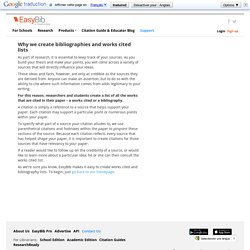
As you build your thesis and make your points, you will come across a variety of sources that will directly influence your ideas. These ideas and facts, however, are only as credible as the sources they are derived from. Anyone can make an assertion, but to do so with the ability to cite where such information comes from adds legitimacy to your writing. For this reason, researchers and students create a list of all the works that are cited in their paper – a works cited or a bibliography. A citation is simply a reference to a source that helps support your paper. To specify what part of a source your citation alludes to, we use parenthetical citations and footnotes within the paper to pinpoint these sections of the source.
If a reader would like to follow up on the credibility of a source, or would like to learn more about a particular idea, he or she can then consult the works cited list. The Chicago Manual of Style Online: Chicago-Style Citation Quick Guide. The Chicago Manual of Style presents two basic documentation systems: (1) notes and bibliography and (2) author-date.
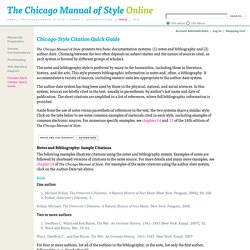
Choosing between the two often depends on subject matter and the nature of sources cited, as each system is favored by different groups of scholars. The notes and bibliography style is preferred by many in the humanities, including those in literature, history, and the arts. This style presents bibliographic information in notes and, often, a bibliography. It accommodates a variety of sources, including esoteric ones less appropriate to the author-date system. The author-date system has long been used by those in the physical, natural, and social sciences. Aside from the use of notes versus parenthetical references in the text, the two systems share a similar style. Notes and Bibliography: Sample Citations The following examples illustrate citations using the notes and bibliography system. Book One author 1. 2. Pollan, Michael. Two or more authors 1. 2. Research and Documentation Online 5th Edition. Research and Documentation Online 5th Edition.
MLA in-text citations are made with a combination of signal phrases and parenthetical references.
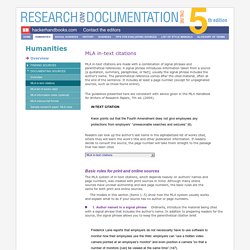
A signal phrase introduces information taken from a source (a quotation, summary, paraphrase, or fact); usually the signal phrase includes the author’s name. The parenthetical reference comes after the cited material, often at the end of the sentence. It includes at least a page number (except for unpaginated sources, such as those found online).
The guidelines presented here are consistent with advice given in the MLA Handbook for Writers of Research Papers, 7th ed. (2009). Kwon points out that the Fourth Amendment does not give employees any protections from employers’ “unreasonable searches and seizures” (6). Readers can look up the author’s last name in the alphabetized list of works cited, where they will learn the work’s title and other publication information. Basic rules for print and online sources 1. Why We Cite. APA Formatting and Style Guide. Summary: APA (American Psychological Association) style is most commonly used to cite sources within the social sciences.
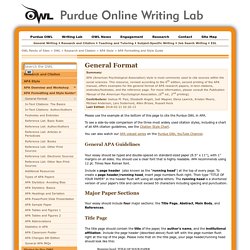
This resource, revised according to the 6th edition, second printing of the APA manual, offers examples for the general format of APA research papers, in-text citations, endnotes/footnotes, and the reference page. For more information, please consult the Publication Manual of the American Psychological Association, (6th ed., 2nd printing). Contributors: Joshua M. Paiz, Elizabeth Angeli, Jodi Wagner, Elena Lawrick, Kristen Moore, Michael Anderson, Lars Soderlund, Allen Brizee, Russell KeckLast Edited: 2018-02-21 02:26:13. MLA Formatting and Style Guide. Coming Soon: A new look for our same great content!
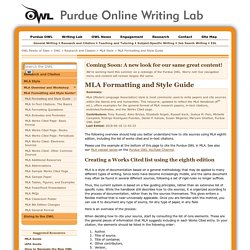
We're working hard this summer on a redesign of the Purdue OWL. Worry not! Our navigation menu and content will remain largely the same. Summary: MLA (Modern Language Association) style is most commonly used to write papers and cite sources within the liberal arts and humanities. Contributors: Tony Russell, Allen Brizee, Elizabeth Angeli, Russell Keck, Joshua M. The following overview should help you better understand how to cite sources using MLA eighth edition, including the list of works cited and in-text citations. Please use the example at the bottom of this page to cite the Purdue OWL in MLA. Creating a Works Cited list using the eighth edition MLA is a style of documentation based on a general methodology that may be applied to many different types of writing. Thus, the current system is based on a few guiding principles, rather than an extensive list of specific rules. Here is an overview of the process: Author. Cite Sources — Plagiarism.org - Best Practices for Ensuring Originality in Written Work.
This depends on what type of work you are writing, how you are using the borrowed material, and the expectations of your instructor.
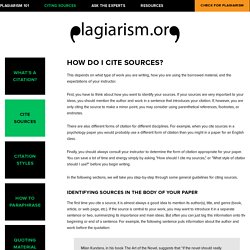
First, you have to think about how you want to identify your sources. If your sources are very important to your ideas, you should mention the author and work in a sentence that introduces your citation. If, however, you are only citing the source to make a minor point, you may consider using parenthetical references, footnotes, or endnotes. There are also different forms of citation for different disciplines. For example, when you cite sources in a psychology paper you would probably use a different form of citation than you might in a paper for an English class. Finally, you should always consult your instructor to determine the form of citation appropriate for your paper.
In the following sections, we will take you step-by-step through some general guidelines for citing sources. Identifying Sources in the Body of Your Paper Quoting Material What is quoting?